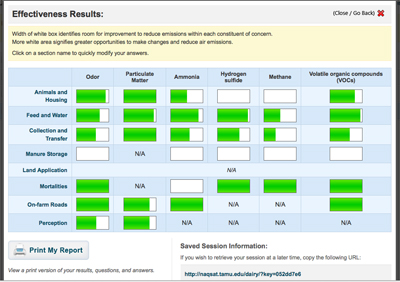All the hype surrounding methane emissions, greenhouse gases, and odors have left most of our brains spinning. It isn't uncommon for us to think, "Ok, so what am I supposed to do?" In addition, regulations on volatile organic compounds, methane, and ammonia are not being imposed in all areas of the country or on all farms. Wendy Powers of Michigan State University recently educated us on a practical new tool that allows all farms to give themselves a progress report on how they are doing in the area of air quality. She presented the tool to participants at the Penn State Dairy Nutrition Conference currently being held in Grantville, Pa.
The assessment takes 30 minutes or less, won't require much data gathering, doesn't give you a score, and isn't traceable. What it does do is evaluate your practices and identify areas of opportunity for improvement on your specific farm. You aren't given bonus points for having a brand new farm or certain types of housing. It simply helps you understand how you can do better with what you do have.
The first step is to go to http://naqsat.tamu.edu. From here, select 'dairy'. At this point, the assessment goes through eight key areas on your farm that relate to air quality. These areas include animals and housing, feed and water, collection and transfer, manure storage, land application, moralities, on-farm roads, and perception. Within each section, several questions are asked to help identify your air quality strengths and weaknesses.

At the completion of the eight areas, click on 'get results'. Your results page will show a matrix of white and green bars for six divisions of air quality in relation to the eight key areas that you answered questions about. They include odor, particulate matter, ammonia, hydrogen sulfide, methane, and volatile organic compounds (VOCs). The more white shown in each bar means greater opportunity for improvement. The more green, the less you can improve. Your results can be viewed at any point in the assessment, so if you don't have time to work through all eight areas, just do one to try it. Once you view your results, feel free to go back and adjust your answers to see how your practices may be improved. At the bottom of the screen, copy your results to do a side-by-side comparison of progress you have made.
The assessment takes 30 minutes or less, won't require much data gathering, doesn't give you a score, and isn't traceable. What it does do is evaluate your practices and identify areas of opportunity for improvement on your specific farm. You aren't given bonus points for having a brand new farm or certain types of housing. It simply helps you understand how you can do better with what you do have.
The first step is to go to http://naqsat.tamu.edu. From here, select 'dairy'. At this point, the assessment goes through eight key areas on your farm that relate to air quality. These areas include animals and housing, feed and water, collection and transfer, manure storage, land application, moralities, on-farm roads, and perception. Within each section, several questions are asked to help identify your air quality strengths and weaknesses.

A sample of what your air quality opportunity report may look like
At the completion of the eight areas, click on 'get results'. Your results page will show a matrix of white and green bars for six divisions of air quality in relation to the eight key areas that you answered questions about. They include odor, particulate matter, ammonia, hydrogen sulfide, methane, and volatile organic compounds (VOCs). The more white shown in each bar means greater opportunity for improvement. The more green, the less you can improve. Your results can be viewed at any point in the assessment, so if you don't have time to work through all eight areas, just do one to try it. Once you view your results, feel free to go back and adjust your answers to see how your practices may be improved. At the bottom of the screen, copy your results to do a side-by-side comparison of progress you have made.








